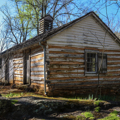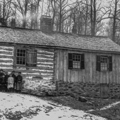During the Middle Woodland 500 BCE to 900 CE and Late Woodland 900 CE to c. 1600 CE periods, Native American buildings in central and western Virginia became more substantial, comprising relatively homogenous features in archaeological sites throughout the region. The built environment of these settlements consistently relied upon earthfast posts, bentwood frames, and rounded plans.
Woodland house plans were typically circular or oval, between ten and thirty-three feet in diameter, with saplings set in the ground around the perimeter. Native builders bent and tied the tops of these flexible posts together, forming an arching framework, which they covered with woven mats or bark. The untreated wood of these bentwood houses left patterns of post molds, recognizable as a different color and consistency of soil during archaeological excavations. The houses contained hearths, benches for sleeping, and pit storage features in their earthen floors. A few sites exhibit greater variability in housing forms, including structures with rectangular plans and longhouses, all in the same bentwood, earthfast style.
Settlement patterns developed over time. During the Middle Woodland period, they shifted gradually from dispersed upland sites to fertile lowlands and floodplains. At the Wingina Site on the northwest bank of the James River in Nelson County, archaeologists encountered elliptical and rounded houses with dimensions between ten and twenty feet, dating to the transitional early tenth century. Nearby, the Wood Site had both Middle and Late Woodland components, indicating the shift to a more concentrated occupational pattern, in which a compact, unpalisaded community of several household clusters formed a narrow ellipse along the river terrace.
As the Late Woodland period progressed, settlements further consolidated as circular towns with exterior palisades of closely spaced wooden posts to aid in defense and demarcate the community, which usually had an open plaza at its center. At the sixteenth-century Crab Orchard site in Tazewell County, three subsequent phases of palisade fences surrounded a progressively expanding town. Although the remains of the town are no longer visible, this site is now part of Tazewell's Historic Crab Orchard Museum. Despite the importance of palisaded towns during the Late Woodland period, dispersed settlements and upland sites continued to exist.
Mortuary structures were important features in western and central Virginia and earthen mounds dating to the Late Woodland period have been found throughout the middle of the state. The dimensions of these accretional mounds were variable, rising as high as fourteen feet and ranging in diameter from twenty to eighty feet. They increased over time with additional interments, but today the effects of plowing, flooding, looting and excavations have left few visible remnants. At least thirteen earthen accretional mounds existed, containing the remains of hundreds or perhaps thousands of individuals with superimposed lenses of earth covering each periodic burial cluster. In 1783, Thomas Jefferson excavated an earthen mound near his property in Albemarle County, the exact location of which is now lost. In his Notes on Virginia, Jefferson observed that unidentified Indian groups still visited accretional mounds in the mid-eighteenth century; recent scholarship attributes the structures to ancestral Monacan Indians living in the Piedmont during the Late Woodland and Contact periods.
Another group of earthen mounds once stood in Lee County. They were larger than earthen accretional mounds, and while some contained burials, they served primarily as foundational pedestals for Mississippian civic-ceremonial structures. Mississippian town sites, which were generally located farther to the south and west of Virginia, included council houses and temples on top of large, substructural mounds, open plazas, and rectangular houses. The Lee County mounds were probably part of periphery Mississippian trading sites in the Appalachian region.
Native architecture in the Piedmont changed little from its Late Woodland forms during the seventeenth century, despite the significant disruptions of migration, warfare, disease, and trade. In the eighteenth century, Siouan groups consolidated as their populations decreased, and by 1714 many were settled at Fort Christanna in Brunswick County. Fort Christanna Indians selectively incorporated aspects of Euro-American architecture, including metal tools, hewn timbers, pitched roofs, and rectangular plans. Despite these changes, they maintained elements of their traditional building practices, constructing their town as a palisaded circle around an open plaza and using earthfast posts and bark-covered roofs for their houses.
As Fort Christanna declined, many residents migrated north to the Iroquois Nations, or south to the Carolinas; others sought refuge in the mountains of Virginia's Amherst and Rockbridge counties. Strategic marriages with white traders enabled these ancestors of today's Monacan Indian Nation to own land, and Bear Mountain became a focus for native residents seeking refuge from increasingly restrictive racial laws. They adopted the regional architectural practice of V-notched log construction, building single-pen houses with fieldstone foundations and chimneys. One such structure, the Bear Mountain Indian Mission School, gained importance as a community center during the segregation era. Monacan buildings now conform to wider architectural trends, but certain structures such as the Mission School, and repatriated remains from excavated burial mounds, remain symbolically important to the revitalized Monacan Indian Nation.
Writing Credits
If SAH Archipedia has been useful to you, please consider supporting it.
SAH Archipedia tells the story of the United States through its buildings, landscapes, and cities. This freely available resource empowers the public with authoritative knowledge that deepens their understanding and appreciation of the built environment. But the Society of Architectural Historians, which created SAH Archipedia with University of Virginia Press, needs your support to maintain the high-caliber research, writing, photography, cartography, editing, design, and programming that make SAH Archipedia a trusted online resource available to all who value the history of place, heritage tourism, and learning.



